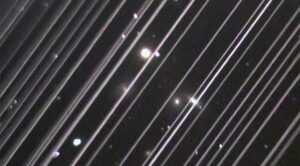“The idea here is to have a one-stop shop for all of your different needs pertaining to low Earth orbit satellite constellation observations,” said Meredith Rawls of the University of Washington, chair of the workshop’s observations working group, at a press briefing about the workshop July 16.
That would include tools to help astronomers more accurately predict satellite passes and other information related to satellite constellations. It would also host software that astronomers can use to both predict satellite passes are to correct images marred by trails from satellites.
“We also really like the SatHub concept,” said Jonathan McDowell of the Harvard & Smithsonian Center for Astrophysics, co-chair of the algorithms working group, at the briefing. “We think that’s a natural home for people to go find the software, find the satellite catalogs, get access to the location predictions and find the documentation.”
SatHub is still in its formative phases. “It will take some time to make SatHub a reality,” Rawls said. A precursor effort, called Trailblazer, may be ready later this year. Astronomers are also looking at funding models for SatHub that could include seeking support from the International Astronomical Union, which is soliciting proposals for projects to address the impacts of satellite constellations on astronomy.
SatHub alone won’t be a solution to the problem, astronomers cautioned. “No software solution can fully mitigate the impact on astronomical observations,” McDowell said, with spectroscopic observations severely affected. “We do think that the software is very important, but it’s not going to be a magic bullet to clean the data.”
Software and other technical solutions may be needed, though, given the slow pace of efforts to develop regulations in the United States and elsewhere to minimize the brightness of satellites. A U.S. federal court blocked a request by Viasat to suspend the Federal Communications Commission’s modification of its license for SpaceX’s Starlink constellation last week. Viasat had argued that such a modification required an environmental review in part because of Starlink’s impact on astronomy.
“Impacts should be considered” in the licensing process, said Richard Green of the University of Arizona, chair of the workshop’s policy working group. However, he said workshop participants didn’t go into details about how agencies like the FCC should do so. “We’re unlikely to go into great detail on how an agency should implement licensing procedures, only that it would be appropriate for them to do so.”
There are similar issues in the United Kingdom. While Ofcom, the UK telecommunications regulator, is taking steps to address potential interference issues among satellite megaconstellations, it has not shown any sign of addressing interference by such systems with astronomical observations.
“Ofcom doesn’t include anything beyond the direct impact on radio astronomy in their remit at the moment,” said Robert Massey, deputy executive director of the Royal Astronomical Society, at a July 23 press conference that was part of the society’s annual National Astronomy Meeting.
He said astronomers hope to make headway with the UK Space Agency. “We have tried to make the point that this should be included” in environmental consultations, “so far without great success.” One reason, he said, is the current focus by the agency and others in the British government on environmental issues associated with launch.
Massey added he hopes to discuss the issue with the new chief executive of the UK Space Agency, Paul Bate, after he starts work in September. “We have to keep making the case,” he said. “There is a certain glacial inertia in this that makes it difficult to shift the thinking.”



